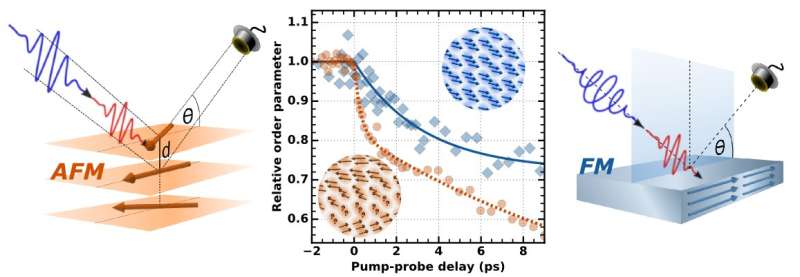Antiferromagnetic dysprosium reveals magnetic switching with less energy

Dysprosium is not only the atomic element with the strongest magnetic moments, but it also possesses another interesting property: Its magnetic moments point either all the same direction (ferromagnetism) or are tilted against each other, depending on the temperature. This makes it possible to investigate within a single sample how differently oriented magnetic moments behave when they are excited by an external energy pulse.
Physicist Dr. Nele Thielemann-Kuehn and her colleagues have now investigated this problem at BESSY II. The BESSY II X-ray source is one of the few facilities worldwide that enables processes as fast as magnetic-order perturbations to be observed. She found that the magnetic orientation in antiferromagnetic dysprosium can be much more easily toggled using a short laser pulse than in ferromagnetic dysprosium.
"This is because the magnetic moments at the atomic level are coupled to angular momenta like a gyroscope," explains Thielemann-Kuehn. Tipping a rotating gyroscope requires force because its angular momentum must be transferred to another body. "Albert Einstein and Wander Johannes de Haas showed in a famous experiment back in 1915 that when the magnetisation of a suspended bar of iron changes, the bar begins to rotate because the angular momenta of the atomic-level magnets in the suspended bar are transferred to it as a whole. If the atomic-level magnetic momenta are already pointing in different directions initially, their angular momenta can interact with one another and cancel each other out, just as if you were to combine two gyroscopes rotating in opposite direction," says Dr. Christian Schuessler-Langeheine, head of the group.
The transfer of angular momentum takes time, though. Antiferromagnetic order, for which this transfer is not required, should therefore be more quickly perturbed than ferromagnetic order. Thielemann-Kuehn and her colleagues have now provided evidence of this. Moreover, the team also discovered that the energy needed in the case of the antiferromagnetic momenta is considerably lower than in the case of ferromagnetic order.
From this observation, the scientists have been able to suggest how materials could be developed with a combination of ferromagnetic and antiferromagnetic aligned spins that are suitable as magnetic storage media and might be switched with considerably lower energy expenditure than material made from conventional magnets.
The study is published in Physical Review B.
Journal information: Physical Review B
Provided by Helmholtz Association of German Research Centres




















